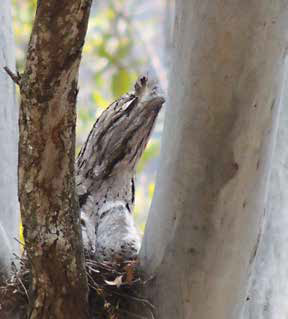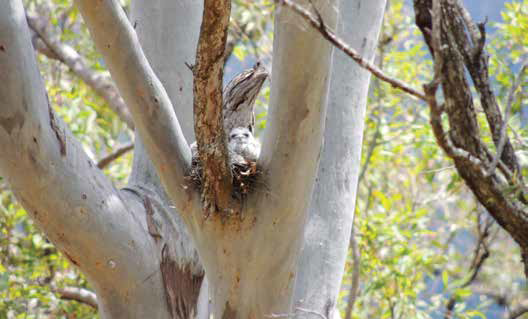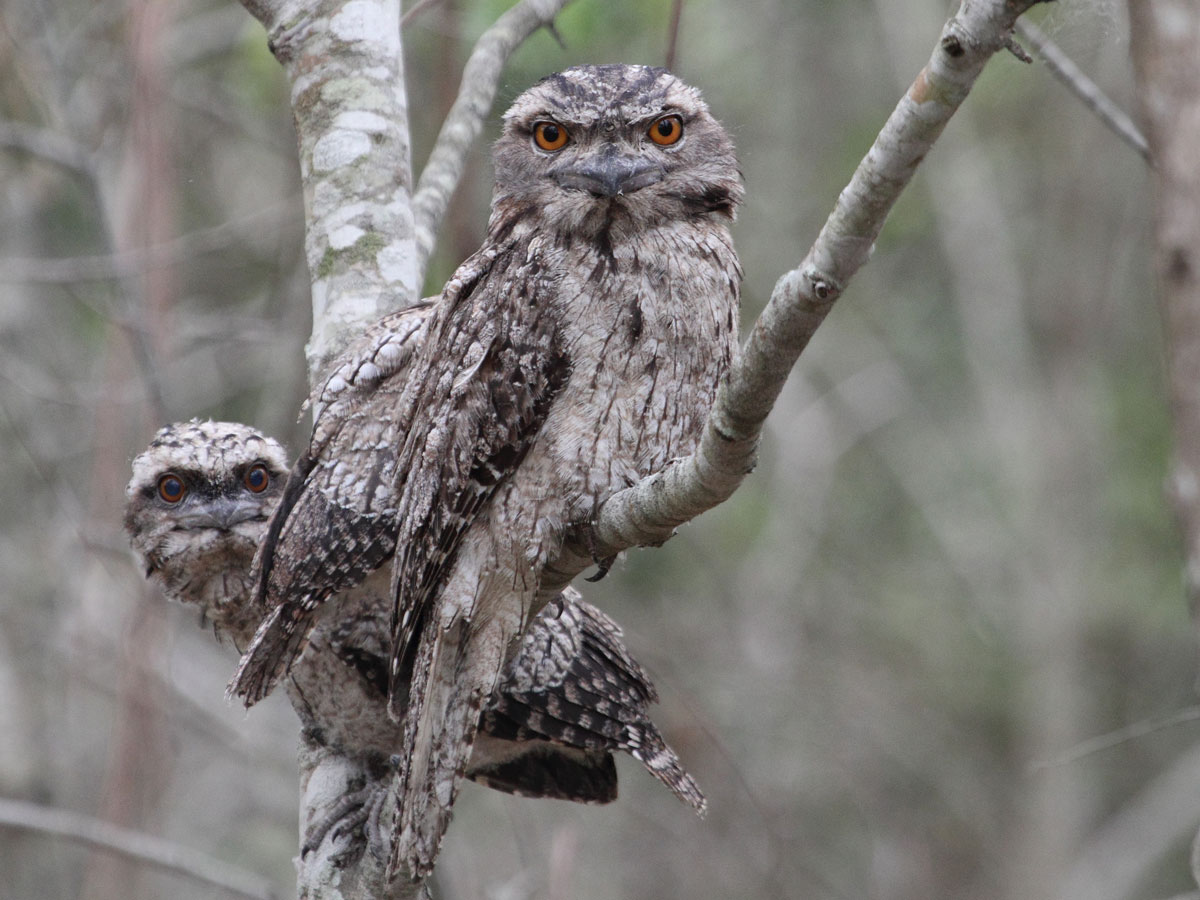The nocturnal Tawny Frogmouth (Podargus strigoides) is a master of disguise. This disguise and camouflage is assembled through a combination of stretched bodies, flattened and coloured feathers, narrowing their eyelids to obscure their yellow eyes and an uncanny ability to stay absolutely still and quiet. Generally perching low down on tree branches during the day, often angling their feet along the tree trunk, the Tawny Frogmouth can easily pass as a dead branch.


(Above:) The adult and nestling both assuming the camouflage pose. Photographs by Kaori van Baalen.
(Left:) A Tawny Frogmouth nest with fluffy, white nestlings (young birds still in the nest) and protective parents found at Thornton in the Lockyer Valley, November 2015.
Nestling fluff balls that were seen last November did not have all of the strategies down pat but they were certainly quick to pick up the posture of disguise. Nestlings as young as two weeks of age have been noted to adopt the camouflage posture.
Tawny Frogmouths are more closely related to nightjars than owls. Although they have the leading edges of their primary feathers fringed to allow for silent flight like owls, they lack the owls curved talons. Tawny Frogmouths generally have a silver-grey plumage, being slightly paler below, with black and rufous streaks and mottling. These birds are found throughout Australia, including Tasmania, ranging across a variety of habitats except dense rainforests and treeless deserts.
Feeding mainly on a variety of nocturnal insects, snails, slugs and worms but also eating frogs, birds and small mammals, Tawny Frogmouths generally pounce on their prey from an elevated perch. However, they also swoop down to catch moths on the wing. Sadly this often results in them being hit by cars in urban areas

An adult and edgling (a young bird that has left the nest) on a Land for Wildlife property at Bellbird Park also in November 2015. Photo by Deborah Metters.
Tawny Frogmouths form lifelong partnerships. Pairs have been noted to roost during the day within 10-15 metres of each other, often sitting next to each other during the breeding season. When they do sit next to each other they can adopt opposite facing camouflage poses so that they look like a tree fork.
Breeding occurs August to December generally resulting in one brood of one to two chicks. Males and females share the nest building though they have been noted to also use suitable abandoned nests. Nests are constructed by parents selecting a horizontal forked tree branch and dropping sticks and leaves onto this forked area. Old native trees are noted to offer the most suitable nesting sites.
It is generally thought that both parents share the brooding at night time with the male taking over full duties during the day. Early to mid-summer fledglings are evicted from the nest and are sexually mature within a year. One banded bird lived to almost 14 years of age. For a chick to survive to such an age it must have survived a variety of predators including goshawks, currawongs, goannas and butcherbirds. Tawny Frogmouths must also face other threats of barbwire fences, cats, dogs, foxes, pesticide ingestion and cars.
What a pleasure and delight to see these precious balls of fluff practising their postures under the careful and protective eye of their parent. Let us hope they have many more years of successful disguises ahead of them.
References & Further Reading
Australian Museum
Kaplan G (2007) Tawny Frogmouth. Australian Natural History Series, CSIRO Publishing.
Qld Dept. Environment & Heritage Protection
Tasmania Parks and Wildlife Service
Article by Kaori van Baalen Land for Wildlife Officer Lockyer Valley Regional Council

just seen my 1st tawny high in some bamboo.. impossible to get a usable photo of it. as a birdwatcher the past 50years it is exciting to have a ne w
bird to add
Wonderful to have a pair of tawnies nest in our backyard for the second year running, and successfully rear another fledgling. Currawongs have been relentless this year, with almost daily assaults. We didn’t see any last year – ? Moved in due to loss of habitat due to bushfires?
Parents valiant and super protective – snap with their beaks, fly at currawongs when they become too aggressive,
Are currawongs common predators in urban areas?
We are in Victoria.
I have witnessed the same in our Victorian backyard. A pair of tawny frogmouths have nested in the same tree for 3 years, raising chicks. Yesterday the currawongs were attacking the nesting bird- I scared them off but today the nest is gone and tawny feathers on the ground…